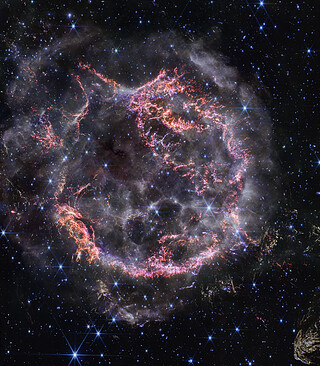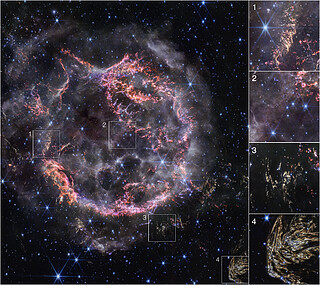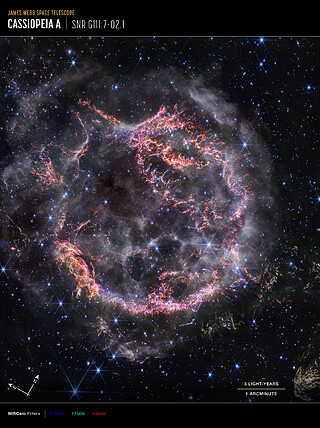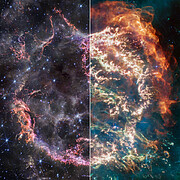weic2330 — Photo Release
Researchers stunned by Webb’s new high-definition look at exploded star
11 December 2023
Like a shiny, round ornament ready to be placed in the perfect spot on the holiday tree, supernova remnant Cassiopeia A (Cas A) gleams in a new image from the NASA/ESA/CSA James Webb Space Telescope. However, this scene is no proverbial silent night — all is not calm.
Webb’s NIRCam (Near-Infrared Camera) view of Cas A displays a very violent explosion at a resolution previously unreachable at these wavelengths. This high-resolution look unveils intricate details of the expanding shell of material slamming into the gas shed by the star before it exploded.
Cas A is one of the best-studied supernova remnants in all the cosmos. Over the years, ground-based and space-based observatories, including the NASA/ESA Hubble Space Telescope, have collectively assembled a multiwavelength picture of the object’s tattered remains.
However, astronomers have now entered a new era in the study of Cas A. In April 2023, Webb’s MIRI (Mid-Infrared Instrument) started this story, revealing new and unexpected features within the inner shell of the supernova remnant. But many of those features are invisible in the new NIRCam image, and astronomers are investigating why that is.
Infrared light is invisible to our eyes, so image processors and scientists represent these wavelengths of light with visible colours. In this newest image of Cas A, colours were assigned to NIRCam’s different filters, and each of those colours hints at different activity occurring within the object.
At first glance, the NIRCam image may appear less colourful than the MIRI image. However, this does not mean there is less information: it simply comes down to the wavelengths in which the material in the object is emitting its light.
The most noticeable colours in Webb’s newest image are clumps of bright orange and light pink that make up the inner shell of the supernova remnant. Webb’s razor-sharp view can detect the tiniest knots of gas, composed of sulphur, oxygen, argon, and neon from the star itself. Embedded in this gas is a mixture of dust and molecules, which will eventually be incorporated into new stars and planetary systems. Some filaments of debris are too tiny to be resolved, even by Webb, meaning that they are comparable to or less than 16 billion kilometres across (around 100 astronomical units). In comparison, the entirety of Cas A spans 10 light-years, or roughly 96 trillion kilometres.
When comparing Webb’s new near-infrared view of Cas A with the mid-infrared view, its inner cavity and outermost shell are curiously devoid of colour. The outskirts of the main inner shell, which appeared as a deep orange and red in the MIRI image, now look like smoke from a campfire. This marks where the supernova blast wave is ramming into the surrounding circumstellar material. The dust in the circumstellar material is too cool to be detected directly at near-infrared wavelengths, but lights up in the mid-infrared.
Researchers have concluded that the white colour is light from synchrotron radiation, which is emitted across the electromagnetic spectrum, including the near-infrared. It’s generated by charged particles travelling at extremely high speeds and spiralling around magnetic field lines. Synchrotron radiation is also visible in the bubble-like shells in the lower half of the inner cavity.
Also not seen in the near-infrared view is the loop of green light in the central cavity of Cas A that glowed in mid-infrared light, appropriately nicknamed the Green Monster by the research team. This feature was described as ‘challenging to understand’ by researchers at the time of their first look.
While the ‘green’ of the Green Monster is not visible in NIRCam, what’s left over in the near-infrared in that region can provide insight into the mysterious feature. The circular holes visible in the MIRI image are faintly outlined in white and purple emission in the NIRCam image — this represents ionised gas. Researchers believe this is due to the supernova debris pushing through and sculpting gas left behind by the star before it exploded.
Researchers were also absolutely stunned by one fascinating feature at the bottom right corner of NIRCam’s field of view. They’re calling that large, striated blob Baby Cas A — because it appears like an offspring of the main supernova.
This is a light echo. Light from the star’s long-ago explosion has reached, and is warming, distant dust, which glows as it cools down. The intricacy of the dust pattern, and Baby Cas A’s apparent proximity to Cas A itself, are particularly intriguing to researchers. In actuality, Baby Cas A is located about 170 light-years behind the supernova remnant.
There are also several other, smaller light echoes scattered throughout Webb’s new portrait.
The Cas A supernova remnant is located 11 000 light-years away in the constellation Cassiopeia. It’s estimated to have exploded about 340 years ago from our point of view.
More information
Webb is the largest, most powerful telescope ever launched into space. Under an international collaboration agreement, ESA provided the telescope’s launch service, using the Ariane 5 launch vehicle. Working with partners, ESA was responsible for the development and qualification of Ariane 5 adaptations for the Webb mission and for the procurement of the launch service by Arianespace. ESA also provided the workhorse spectrograph NIRSpec and 50% of the mid-infrared instrument MIRI, which was designed and built by a consortium of nationally funded European Institutes (The MIRI European Consortium) in partnership with JPL and the University of Arizona.
Webb is an international partnership between NASA, ESA and the Canadian Space Agency (CSA).
Image Credit: NASA, ESA, CSA, STScI, D. Milisavljevic (Purdue University), T. Temim (Princeton University), I. De Looze (University of Gent)
Links
- ESA Webb Seeing Farther Interactive Brochure
- Webb’s MIRI image of Cas A (April 2023)
- Release on ESA website
- Release on STScI website
- Release on NASA website
Contacts
Bethany Downer
ESA/Webb Chief Science Communications Officer
Email: [email protected]
Ninja Menning
ESA Newsroom and Media Relations Office
Email: [email protected]
About the Release
| Release No.: | weic2330 | |
|---|---|---|










